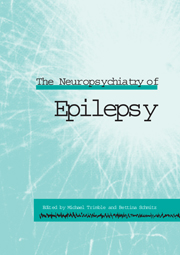Book contents
- Frontmatter
- Contents
- List of contributors
- Part I Background
- Part II Clinical aspects
- Part III Cognitive aspects
- Part IV Nonepileptic attacks
- Part V Treatment complications
- 16 The effects if antiepileptic drugs on behaviour
- 17 Antiepileptic drug treatment and epileptic seizures – effects on cognitive function
- 18 Psychiatric effects of surgery for temporal lobe epilepsy
- 19 Vagus nerve stimulation and mood
- Part VI Treatment
- Index
18 - Psychiatric effects of surgery for temporal lobe epilepsy
Published online by Cambridge University Press: 05 October 2010
- Frontmatter
- Contents
- List of contributors
- Part I Background
- Part II Clinical aspects
- Part III Cognitive aspects
- Part IV Nonepileptic attacks
- Part V Treatment complications
- 16 The effects if antiepileptic drugs on behaviour
- 17 Antiepileptic drug treatment and epileptic seizures – effects on cognitive function
- 18 Psychiatric effects of surgery for temporal lobe epilepsy
- 19 Vagus nerve stimulation and mood
- Part VI Treatment
- Index
Summary
Introduction
The cessation of epilepsy by surgical intervention–although it may be an end in itself – primarily aims at a reduction of injuries and embarrassment, in order to enable patients to do what they formerly were precluded from doing. It offers possibilities to live a more fulfilled and self-confident life. But ‘if the disasters and injuries are somehow self-imposed, if the embarrassment arises mainly from peculiarities of character, if the sense of stigmatization is a deeply held conviction … removing the epilepsy will not necessarily alter these conditions’ (Taylor et al., 1997). Those patients – although seizure-free – may stay in their disabled situation.
The experience that the results of epilepsy surgery (ES) – even if successful from a neurological point of view – may be far from satisfying for special groups of patients leads to the following discussion.
On the one hand, a growing interest in psychiatric comorbidity has led to better prognostic knowledge about negative outcomes. This led to a tendency to set up contraindications for surgery for those patients who suffered from the most severe psychiatric disorders, namely chronic psychoses, because this patient group continued to exhibit their psychotic features postoperatively, and the positive effects of the surgical intervention seemed doubtful. In principle, this strategy to exclude patients with predictable barriers to surgical success is reasonable, but it is still unclear which group of psychotic patients to preclude from surgery (see below).
- Type
- Chapter
- Information
- The Neuropsychiatry of Epilepsy , pp. 266 - 282Publisher: Cambridge University PressPrint publication year: 2002
- 6
- Cited by



